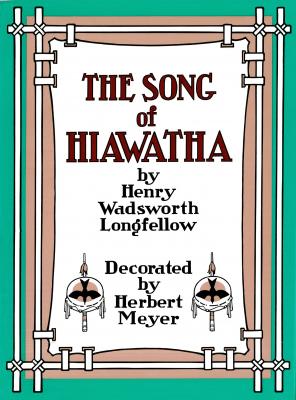Song of Hiawatha. Генри Уодсуорт Лонгфелло
Читать онлайн.| Название | Song of Hiawatha |
|---|---|
| Автор произведения | Генри Уодсуорт Лонгфелло |
| Жанр | Зарубежные стихи |
| Серия | |
| Издательство | Зарубежные стихи |
| Год выпуска | 0 |
| isbn | 9781462912360 |
Shawondasee 36
The moonrise 43
The red deer 44
The battle 53
The arrow-maker and his daughter 55
Hiawatha's cry 58
The friend of man, Mondamin 60
The heron, the Shuh-shuh-gah 62
Driving away the ravens 66
Chibiabos, the musician 70
Lazy Kwasind 73
Canoe building 76
Kagh, the Hedgehog 78
The Birch Canoe 79
Safe passage 81
Hiawatha and the sturgeon 86
The lifeless Nahma 89
Hiawatha and Megissogwon 98
The woodpecker, Mama 100
The Falls of Minnehaha 104
Hiawatha and Minnehaha 109
Messengers 113
The merry Pau-Puk-Keewis 116
The Red Swan 122
Osseo and Oweenee 124
Her staff became a feather 128
Osseo's birds 131
Song 133
Harvest 136
Hiawatha and the ravens 139
Hiawatha's writing 145
Wonderful and mystic figures 146
Hunting all alone 151
Medicine men 153
Hiawatha's healing 155
The lodge of Pau-Puk-Keewis 160
The game 163
Pau-Puk-Keewis and attendant 165
Kahgahgee, the King of Ravens 166
Pau-Puk-Keewis 167
The beaver 170
Imploring the tempest 178
Kwasind on the river 185
Winter 188
Two women entered 189
Bringing fire-wood 191
The departed 193
The cruel winter 197
Still and speechless 200
Spring 203
Iagoo, the great traveller 207
Hiawatha and the black-robe 213
Hiawatha's farewell 217
Into the sunset 219
"Art is long and time is fleeting," Longfellow's Song of Life affirms. It's a safe assumption that Longfellow's own poetic art, in The Song of Hiawatha, will live for a long time, and that Herbert Meyer's unusual and memorable illustrations will help to perpetuate Longfellow's timeless creation.
The late Herbert Meyer's Hiawatha illustrations are unique in their relationship to the woodblock prints of the great Japanese artist Katsushika Hokusai (1760-1849). When the 23-year-old Meyer first saw Hokusai's Views of Mount Fuji, they changed his outlook, opening a "new and enchanting world" to him. He not only admitted his debt to the Japanese genre artist, but was proud of it. "What I learned from Hokusai," he wrote, "I employed in my Hiawatha pictures." Years later, the noted American artist-illustrator considered Hokusai, with Cézanne, the artist who had "played the most powerful part" in his development.
Meyer's approach to the American Indian theme was similarly enthusiastic; he did extensive research into Indian lore for the Hiawatha illustrations. His work is represented in the collections of the Metropolitan and Whitney museums in New York City, and in other museums throughout the country.
The publisher is proud to present this new edition of an old American favorite, authentically and unforgettably illustrated by a distinguished American artist.
by Teiji Chizawa
Chief Curator
Tokyo National Museum
Hokusai's Views of Mount Fuji deeply influenced Herbert Meyer. "I saw life through art—very differently," he wrote, recalling his discovery of the woodblock print series by one of the leading Japanese artists of the 19th century.
Something in the Hokusai prints must have attracted this sensitive young American artist. Certainly the treatment of color, brush line, and composition in the Japanese genre (ukiyoe) print, as represented by the work of Hokusai, differs markedly from that in the European tradition of woodblock art. But the Japanese influence is shown differently in Meyer's work than in the paintings of European artists such as Vincent van Gogh and Paul Gauguin. Rather than direct quotation, we find Meyer's own appreciation and understanding of ukiyoe.
Suggestions of Hokusai can easily be detected in Meyer's techniques; the exaggeration of certain sections, heightening the effect or increasing attention by unusual, dynamic composition; the method of painting creases in mountain ranges with fragmentary, short horizontal and vertical lines; the pointillist (tembyo) touches in the depiction of falling snow. In Meyer's art, as in Hokusai's, one finds surfaces divided with heavy black outlines emphasizing shape and rhythm, or flowers and leaves printed in soft tones with a wide expanse of the same color enhancing the sense of freshness and charm. Meyer also responds to Hokusai in adapting the traditional Chinese perspective, dividing the composition into three horizontal sections to represent near, middle, and far distances; he shows interest in the vertical rectangular compositions known as hashira-e, or narrow, pillar-like designs; he does not use the Western method to indicate clouds, but experiments persistently in depicting them through stylized description.
These methods and treatments are not limited to Hokusai alone; they are the property of all Japanese woodblock artists and,
